Pruning currants in the spring for a good harvest
We all love to enjoy delicious currant berries in the summer. But in order for the currants to produce good yields every year, they should be cut regularly.
This article will be devoted to when and how to properly cut currants in spring.
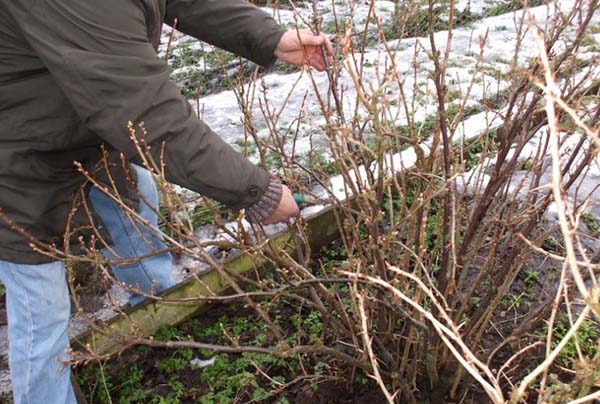
Content
Why cut currants
Every berry bush, like a fruit tree, needs annual pruning if you want to get regular harvests and prolong the life of your plant.
The fact is that the main crop of black currant is formed on branches of 1-3 years old, mostly on their young one-year growth.4-year-old, and also especially older 5-year-old branches give a weak growth and, accordingly, a very weak harvest, in other words, they no longer bear fruit in full force, but only suck nutrients from the bush and the ground. The situation is aggravated by the fact that old branches are often affected by diseases, overshadow the bush and prevent young shoots from developing.
Note! Next, we will talk about pruning black currants, about the nuances and differences between white and red - read in a separate paragraph (in general, the differences are not very serious).
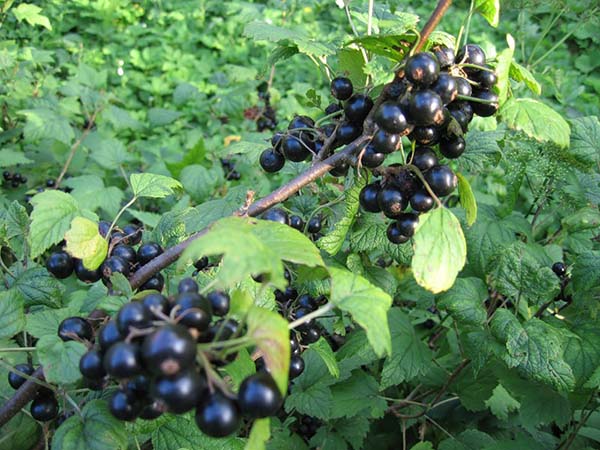
Timely and correct pruning of currants provokes the growth of new basal shoots from the underground part of the bush, which are also sometimes called "zero" or annual, and also promotes better branching of the bush on perennial branches. Thus, the constant replacement of shoots does not allow the berry bushes to stagnate, forcing it to bear fruit abundantly every year.
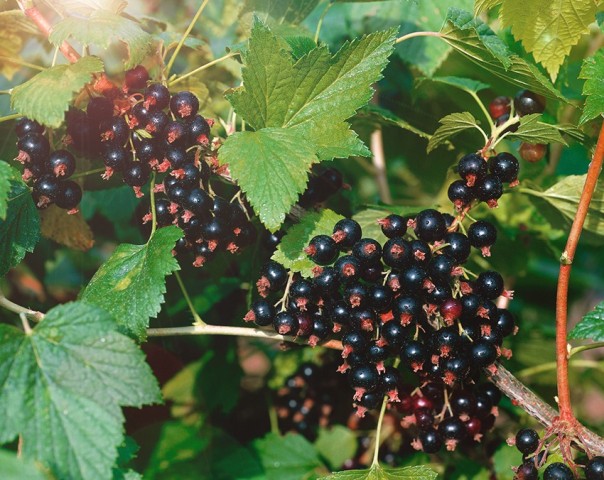
When to cut currants in spring: optimal timing
The event is held immediately, as soon as the snow has melted (or is just starting to melt), necessarily before the moment of awakening and budding.
So, the approximate timing of spring currant pruning is March-April (early May). In the South of Russia - earlier, in more northern regions (Urals and Siberia), as well as in the Middle zone (Moscow region) - much later.
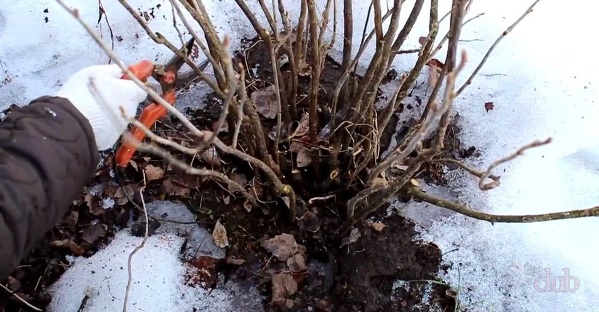
If you cut it off after bud break, then this will greatly injure the shrub. As a result, it will heal the received wounds for a long period of time, which means that its fruiting will begin with some delay.
In the picture below, the vegetation of the currant has already begun, therefore, with pruning you are already late and, it is better to postpone it for autumn.

Video: pruning black currants in spring and autumn, when and how best to carry out
When is the best time to prune - in spring or autumn
Many gardeners cannot decide when it is better to cut currants - in spring or autumn. In general, pruning can be carried out both in early spring and in autumn.
However, in spring there is much less time to cut currants than in autumn. This is due to the fact that when spring comes, the fruit buds of the bush swell very early (in March-April), in other words, it can be problematic to have time.
Therefore, most often currant pruning is carried out even in summer, after harvest, and in late autumn, and in the spring they only control the results. Although, again, whatever is more convenient for you.
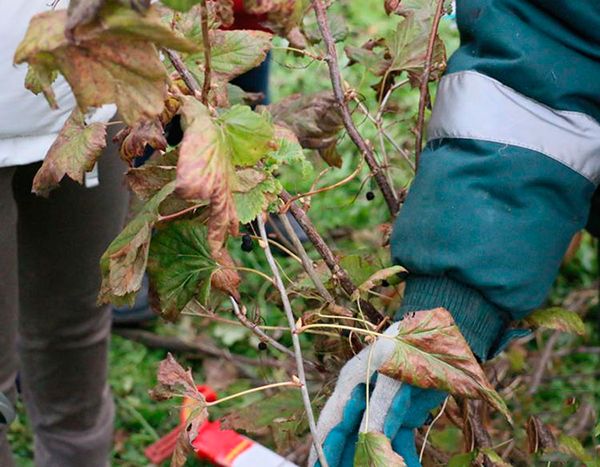
Important! If for some reason you still missed spring pruningthen in the fall, in principle, everything is done in the same way.
Basic rules and recommendations for spring currant pruning
Before proceeding with the direct pruning of currants, you should familiarize yourself with the basic rules, otherwise it will not bring any benefit. In addition, it is very important to prepare the necessary tools.
Advice! In the future, when cutting currants, it will help you a lot if you know the structure of its bush.
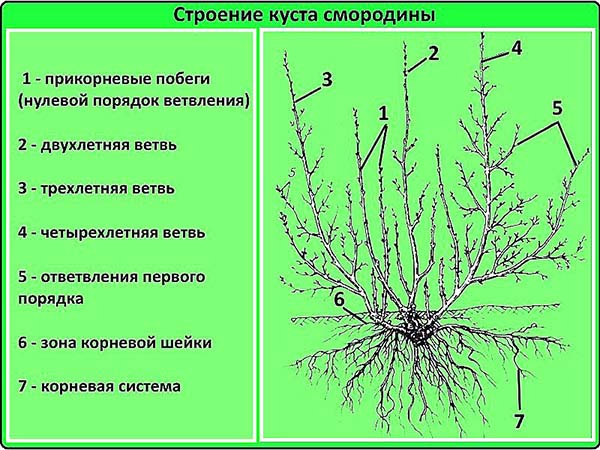
Tools
For work on pruning a bush, it is imperative to use a special garden tool (you should never break off branches with your hands), namely the most common pruner. It is even better to take a pruner with long handles (lopper). And for very old and thick branches, you will most likely need a small hand saw.
Naturally, the entire tool must be well sharpened.
What and how to cut correctly (which branches and shoots)
What branches and shoots currants need to cut in spring:
- All diseased (for example, branches with mite buds, bent shoots affected by aphids), covered with moss and lichen, dried out and damaged.
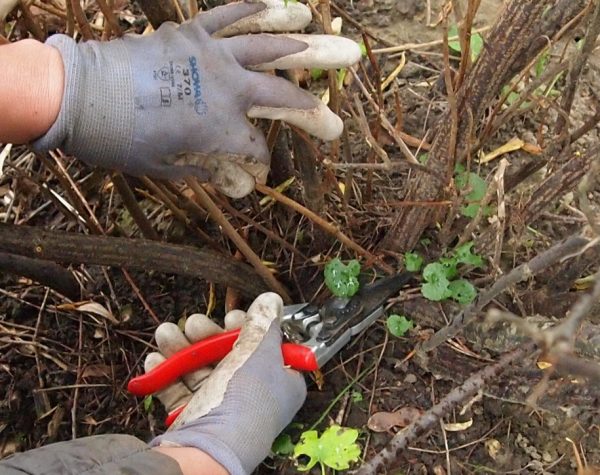
- All old branches, from 4-5 years old.
How to distinguish old branches from young ones is described below.
- Branches, strongly inclined to the ground (practically lying on the surface of the ground), because in the summer they will still not have enough light for full fruiting.
- In addition, one should delete all branches growing in the center (inside) of the bushso that they do not thicken it.
In order for the shrub to bear fruit well and not get sick, it must be well lit and ventilated.
- As for pruning zero (annual) young shootsthen it is recommended leave 3-5 such shoots (the strongest), so as not to thicken the bush, and the rest you need completely cut.
- The young shoots themselves of replacement (zero) need shorten by 1/3, over the kidneysto branch better.
- It is also necessary to update 2-3-year-old branches. Should get rid of a competing one-year growth to a strong lateral branch (weaker shoots with fewer buds should be removed) to enhance the growth of the rest of the branch.
- Also for better branching it is recommended trim the tops of a new growth on 2-3 year old branches above the buds (all the more it is necessary to shorten the branches of the second order if their length exceeds 40-50 cm).
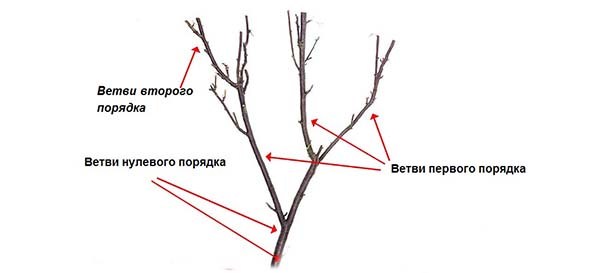
Important! If you shorten a branch and see that centered inside her black hole, that is, she amazed by the glassthen such an escape must be completely removed. Although, of course, you can try to trim it to healthy wood, but most often you have to cut it completely (to the bottom).
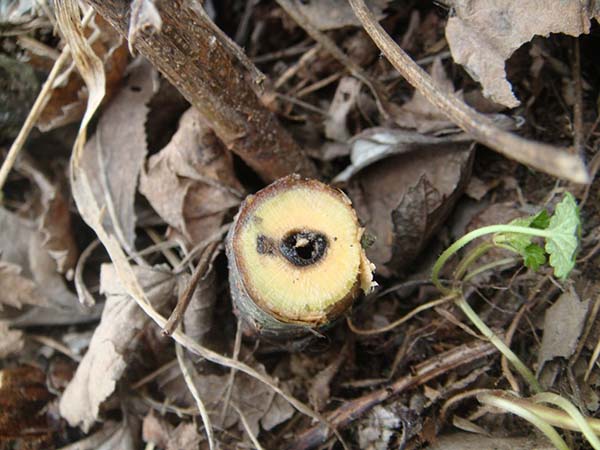
How to prune branches and shoots correctly currants in spring:
- Sick, damaged and old (4-5 year old) branches and shootscut required completelypractically flush with the ground, being careful not to leave stumps.
If you leave high hemp, then in the end you can get a kind of "hedgehog" of hemp.
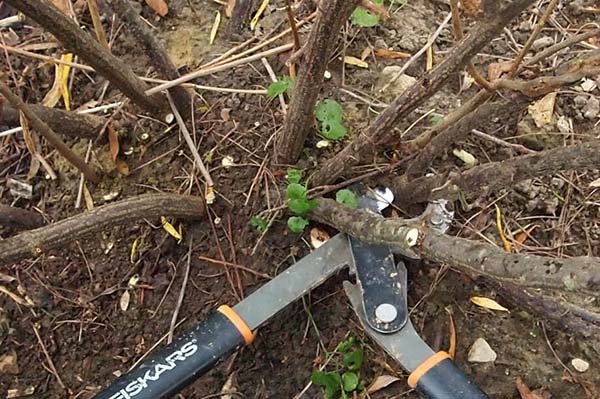
- When you pinch or shorten young shoots, then they need to be pruned to the bud, and precisely to the outside, so that the new shoot begins to grow outward, and not inside the bush.
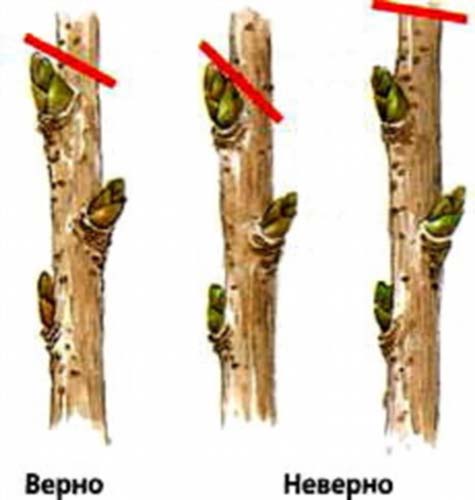
- Distinguish young shoots from old branches quite simple: old branches (3-5 years old) are thick and dark brown (almost black) in color (they usually still have outgrowths of lichens or mosses), while fresh 1-2 year old shoots are thin and have lighter wood ...
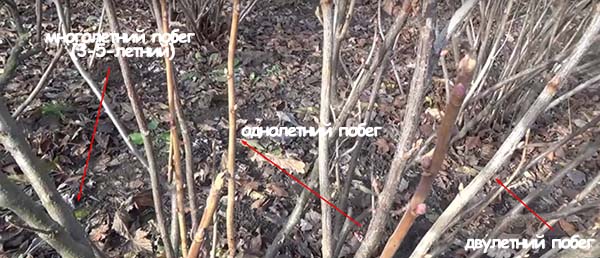
By the way! The tops of the currant, left after the shortening of annual branches, are convenient to use as cuttings for rooting before winter, in other words, at the same time, you can propagate the shrub using cuttings.
Video: how to prune black currants in spring
Differences in pruning red and white currants from black
One of the main differences in pruning white and red currants from black is the fact that the latter pruned much more frequently... In other words, the black variety requires more control in growth and, accordingly, is pruned more often. The growth of red and white currants zero shoots more discreetbesides she can bear fruit normally even on 5-7 year old branches, while black is only for 3-4 year olds. Thus, if you do not regularly prune black currants, then it will crush itself with overgrown branches deep into the bush. The same applies to red and white currants, but in this case there is no such need to remove branches older than 4-5 years.
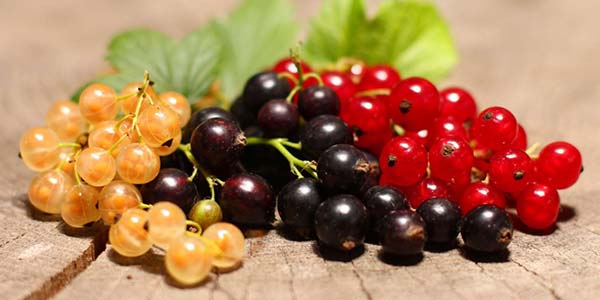
Important! If the annual growth rate of perennial branches of red and white currants becomes less than 15 centimeters, then they should be disposed of. However, when pruning old branches with multiple branches in red and white currants, you need to be careful, because they give a fairly good yield (in contrast to the black variety).
Video: pruning red currants for a good harvest
Another important difference in pruning is that in black currants, the tops should not be shortened very much, otherwise you will be left without a significant part of the harvest, whereas in red and white it is quite acceptable.
Video: what is the difference between cutting black and red currants
How to shape a young currant bush and prune an old one: formative and rejuvenating pruning in spring
Depending on the age of the bushes, the specificity of pruning is also different - the formation of young currants (from the moment the seedling is planted) and the rejuvenation of the old culture.
How to form currants in the spring by years: a formative pruning scheme
If you are growing a shrub from scratch, planting it with a one year old seedling (in the spring or in the fall), then you should adhere to a certain scheme for trimming currants as it grows, or rather, correctly form your currant bush year after year, for 4 years:
The following describes the formation scheme on the example of black currant.
- After planting a seedling - everything that is above 4 buds from the base of the soil is removed. This radical pruning contributes to the correct formation of the crown. Next year, at least 4-8 young shoots will grow from the remaining buds.
- After 1 year - pruning (more precisely, pinching) of the tops of all young branches is carried out by 1/3 of their length above the buds.
- After 2 years - again pruning (pinching) of all zero shoots is carried out, as well as part of the skeletal branches. On 2-year-old branches, you need to get rid of competing annual branches by pruning for translation, i.e. to the lateral branch (you need to leave stronger shoots with more buds). To enhance the growth of the remaining part of the branch, for better branching, prune (pinch) the tops of all other growths of the first and second order above their buds. This will provoke the growth of a young shrub in width.
- After 3 years - fully correspond to pruning on a 3-year-old seedling. Again, you need to eliminate all shoots that thicken the inner branches of the bush, competing branches, and also pinch the tops.
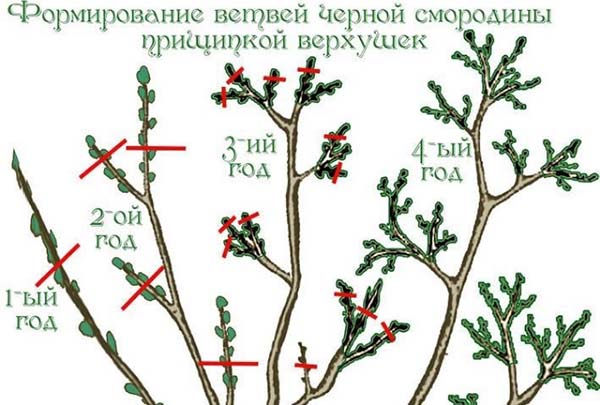
If all the conditions are met correctly, then by the 4th year you will get a lush, correctly formed shrub.
- For 4 years and beyond - at this moment, aging shoots are already beginning to form. At the end of the season, remove all 4-year old branches at the root. All other shoots after the 4th year of the plant's life are pruned according to the type of 2 years. In addition, it is necessary to leave 3-6 new zero replacement shoots every year.
Thus, as a result, a 4-year-old bush should have about 9-18 branches of the zero order of different ages. The classic scheme: 3-6 branches of annuals, 3-6 branches of biennial and 3-6 three-year-olds, as well as 3-6- four-year olds, which must be removed and will be replaced with annuals.
You can see an illustrated diagram of pruning (formation) of black currant by year in the picture below:
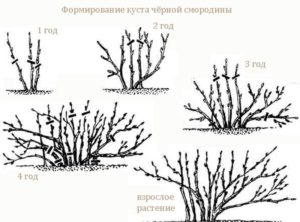
Important! When trimming and shaping red or white currant there are a couple of nuances that are described in a separate paragraph (above).
What to do with an old and neglected bush - how is it trim
If you inherited an old plot or you bought a summer cottage with overly thickened currant bushes (but they are not more than 10-15 years old), which give a scanty harvest, then, in principle, you can try to reanimate it by doing the correct anti-aging pruning.
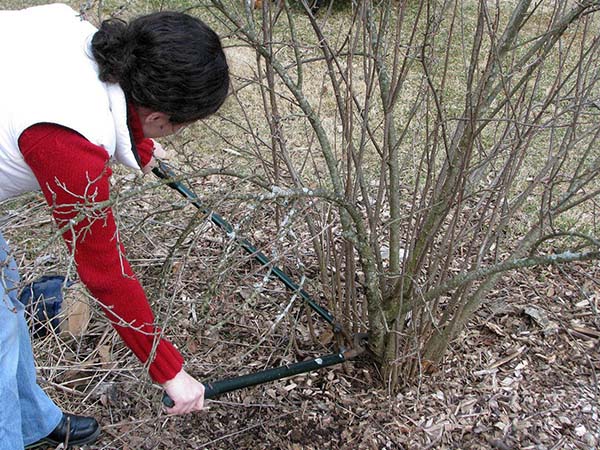
By the way! The currant bush can grow well and bear fruit normally no more than 10-15 years (the maximum is 20 years). Then you need to get rid of it, and first plant or transplant (spring or autumn)by propagating in one of the vegetative ways.
Naturally, it's better to start with sanitary pruning currant bush, and then cut and all old branches... The bush will be cleared, in other words, the necessary conditions will be created for the growth of young shoots of zero order.
However, if you do not want to lose most of the crop and extend the yield for another year, then, alternatively, you can cut off old branches by transferring to younger shoots.
And if it's too much old branches (5 years and older)where absolutely no young growth (and in most cases they are struck by glass), then, of course, they are required remove completely.
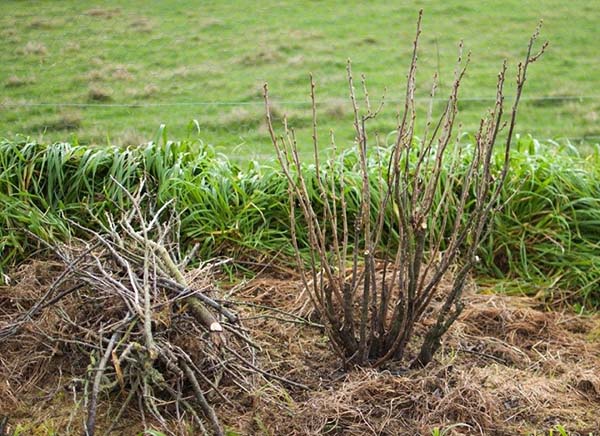
Video: rejuvenating pruning of an old currant bush in the spring, so as not to lose the harvest
What else is included in the spring currant care activities
Thus, proper care for currants in spring includes the following activities:
- direct spring pruning;
- treatment of shrubs from diseases and pests;
By the way! The site already has an article about how to properly spray currants in the spring from pests and diseases.
- and top dressing.
By the way! The site also has detailed material on how how to feed currants in spring for a good harvest.
Thus, pruning currants is a mandatory annual (spring or autumn) agrotechnical procedure that allows you to get regular and high-quality yields of delicious berries, which even a novice gardener can handle with due diligence.
Video: how to properly cut young and old black currant bushes

